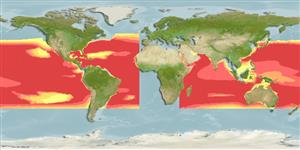>
Beryciformes (Sawbellies) >
Cetomimidae (Flabby whalefishes)
Etymology: Cetostoma: Greek, ketos = a marine monster, whale + Greek, stoma = mouth (Ref. 45335).
Environment: milieu / climate zone / depth range / distribution range
Ecologia
marino batipelagico; distribuzione batimetrica 0 - 2250 m (Ref. 6715). Deep-water; 50°N - 40°S, 35°E - 13°W
Atlantic Ocean: between 50°N to 40°S; one specimen was recorded at 30°45'N, 25°47'W (Ref. 6715) and 8 specimens from 28°N, 16°E. Indian Ocean: between15°N and 31°S. Pacific Ocean: between 45°N and 15°S, and off central California, USA.
Size / Peso / Age
Maturity: Lm ? range ? - ? cm
Max length : 24.7 cm SL maschio/sesso non determinato; (Ref. 9791)
Short description
Morfologia | Morfometria
Spine dorsali (totale): 0; Raggi dorsali molli (totale): 29-37; Spine anali 0; Raggi anali molli: 26 - 34; Vertebre: 47 - 53
Normal diurnal distribution is between 700 and 1200 m The shallowest diurnal capture (500-600 m) is of one of the smallest specimens (4.3 cm) and the deepest (1500-1600 m) is of one of the largest (20.4 cm), indicating a trend for the diurnal depth to increase with increasing size (Ref. 9791). Nocturnal distribution is between 110-700 m (Ref. 9791). Feeds on decapods and euphausiids (Ref. 6715). Minimum depth from Ref. 58018.
Life cycle and mating behavior
Maturità | Riproduzione | Deposizione | Uova | Fecundity | Larve
Paxton, J.R. and D.J. Blake, 1990. Cetomimidae. p. 607-608. In J.C. Quero, J.C. Hureau, C. Karrer, A. Post and L. Saldanha (eds.) Check-list of the fishes of the eastern tropical Atlantic (CLOFETA). JNICT, Lisbon; SEI, Paris; and UNESCO, Parisl. Vol. 2. (Ref. 6532)
IUCN Red List Status (Ref. 130435)
Threat to humans
Harmless
Human uses
Informazioni ulteriori
Nomi ComuniSinonimiMetabolismoPredatoriEcotossicologiaRiproduzioneMaturitàDeposizioneSpawning aggregationFecundityUovaEgg development
Age/SizeAccrescimentoLength-weightLength-lengthLength-frequenciesMorfometriaMorfologiaLarveDinamica popolazioni larvaliReclutamentoAbbondanzaBRUVS
BibliografiaAcquacolturaProfilo di acquacolturaVarietàGeneticaElectrophoresesEreditarietàMalattieElaborazioneNutrientsMass conversion
Strumenti
Special reports
Download XML
Fonti Internet
Estimates based on models
Preferred temperature (Ref.
123201): 4.9 - 13.9, mean 8.1 °C (based on 1132 cells).
Phylogenetic diversity index (Ref.
82804): PD
50 = 1.0000 [Uniqueness, from 0.5 = low to 2.0 = high].
Bayesian length-weight: a=0.00389 (0.00180 - 0.00842), b=3.12 (2.94 - 3.30), in cm total length, based on all LWR estimates for this body shape (Ref.
93245).
Trophic level (Ref.
69278): 3.4 ±0.45 se; based on food items.
Generation time: 1.6 ( na - na) years. Estimated as median ln(3)/K based on 1
growth studies.
Resilienza (Ref.
120179): Medio, tempo minimo di raddoppiamento della popolazione 1.4 - 4.4 anni (Assuming tmax>3).
Fishing Vulnerability (Ref.
59153): Low vulnerability (22 of 100).
